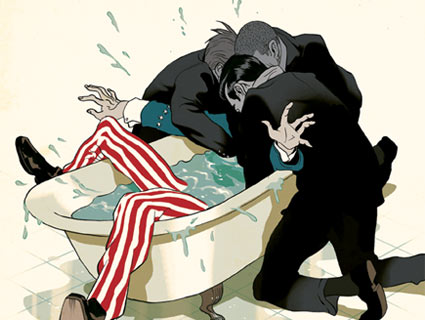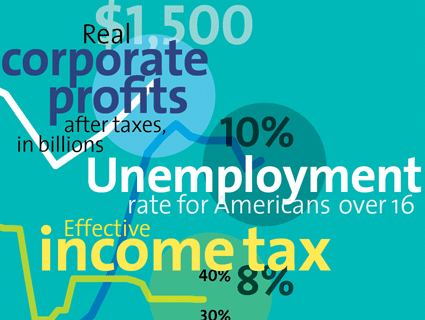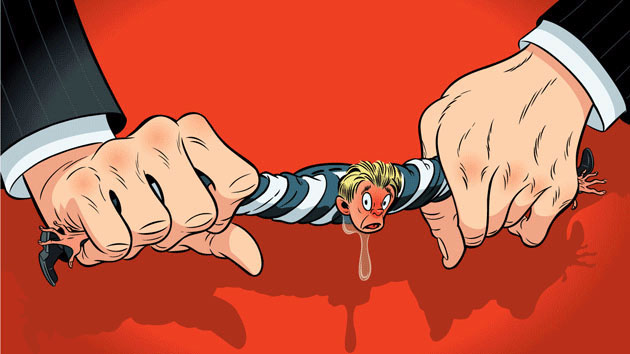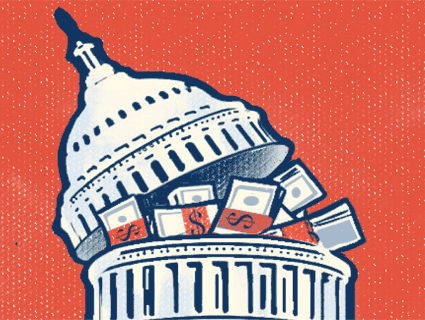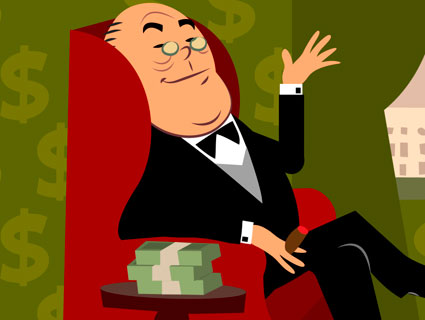
Illustration by <a href="http://motherjones.com/authors/zina-saunders">Zina Saunders</a>. See the full animation, "What the One Percent Thinks About OWS," <a href="http://motherjones.com/media/2011/10/zina-saunders-one-percent-occupy-wall-street">here</a>.
In the movie Groundhog Day, Bill Murray’s character is forced to relive a single day over and over and over—waking up to the same song every morning, meeting the same people, having the same conversations—until, after thousands of repetitions, he finally realizes what a shmo he’s been his entire life. With that epiphany, the calendar starts to flip forward again. His life reboots, and he once again gets to hear new songs, meet new people, and have entirely new conversations.
When it comes to the economy, we’re stuck in our own version of Groundhog Day—and this one doesn’t seem to be coming to an end. America is in a deep and persistent slump, and unemployment is mired at more than 9 percent. Yet when you turn on the TV, all you hear are the same manufactured sound bites delivered in the same apocalyptic tones from the same pack of talking heads—over and over and over. Groundhog Day has turned into the eighth circle of hell.
Unfortunately, these zombie talking points aren’t just wrong; they’re dangerous. If we’re ever going to revive the economy, we’ve got to tackle them head on. Here are six of the worst.
Myth #1: The stimulus failed.
For the first four years of his presidency, Franklin Roosevelt tackled the Great Depression with inflation, easy monetary policy, and government spending. But in 1937, FDR’s advisers persuaded him to reverse gears. After all, interest rates had been close to zero for years, commodity prices were climbing, and fear of inflation was on the rise.
Bust or Boost?

What happened next is now called the “Mistake of 1937” (PDF). Federal spending was cut and monetary policy was tightened up, with disastrous results: GDP immediately began to plummet, and industrial production fell by a third. Within a year everyone had had enough. In 1938 the austerity program was abandoned, and the economy started to grow again.
The truth is that stimulus worked in 1933 and it worked in 2009. So why is our economy still in such bad shape? For one, partly due to political considerations and partly because it was rushed through Congress, the 2009 stimulus wasn’t as well designed as it could have been. It was also sold badly. If the bill passed, administration economists predicted, unemployment would peak at 8 percent and then start declining (PDF). But the recession was far worse than the White House originally thought. Unemployment peaked in the double digits, and that’s made the stimulus a fat target for Republican critics ever since.
But as awkward as it is to argue that things would have been worse without the stimulus—”Not as bad as it could have been!” isn’t a winning slogan—well, the truth is that things would have been a lot worse without the stimulus. Everyone from the nonpartisan Congressional Budget Office (PDF) to private-sector forecasting firms have concluded that it increased economic growth, reduced unemployment, and put millions of people back to work. It just wasn’t big enough, or long-lasting enough. Unfortunately, this has given conservatives an opening to demand tighter money and lower spending—exactly the same mistake we made in 1937.
Myth #2: The deficit is our biggest problem right now.
If your credit card company offered you $30,000 interest-free to buy a car, would you take the deal? Sure you would. It’s a three-way win: You replace your clunker, the auto industry keeps its assembly lines humming, and the credit card company is happy to have made a safe loan, even at no interest. Apparently, they think you’re a pretty good credit risk.
The Bush Effect
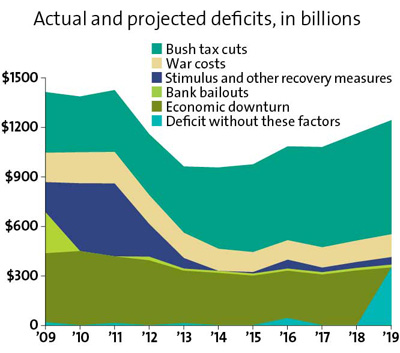
This is pretty much the situation the US government is in now. If our national debt were really at dire and unsustainable levels, as conservative economists and Republican leaders have taken to arguing, nervous investors would be driving up interest rates on federal borrowing. But just the opposite has happened: As I’m writing this, 10-year real treasury yields are at 0.00 percent. The seven-year rate is actually negative. Apparently, the financial markets think we’re a pretty good credit risk.
It’s true that the United States needs to address its long-term deficit problem—a problem almost entirely due to Medicare and other health care expenditures. (Domestic, defense, and Social Security spending have actually decreased as a percentage of GDP over the past 40 years, and there’s no reason to think that’s about to change.) But that’s in the long term. Right now, our problem is a sluggish economy and too many people out of work. The real answer to future deficits is to spend money now to get the economy growing again.
America’s infrastructure is crumbling, there are people who could be put to work fixing it, and banks are practically begging us to take their money. A trillion dollars in infrastructure spending would be good for our economy today, good for economic growth tomorrow, and thanks to those low interest rates (and the increased revenue that would come from growth), it wouldn’t even increase our debt much. As they say, only an idiot turns down free money.
Only an Idiot Turns Down Free Money
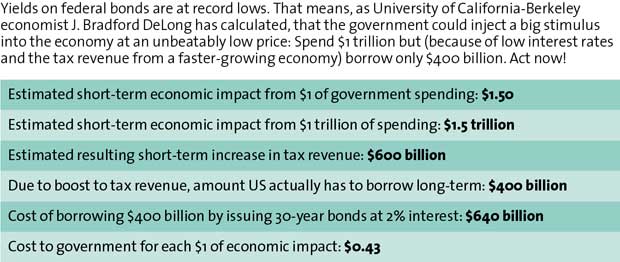
Myth #3: Lower taxes are the best way to grow the economy.
There’s no greater orthodoxy in the Republican Party than unconditional fealty to tax cuts. In a recent GOP debate, when the candidates were asked whether they’d walk away from a deficit deal that included just $1 in tax increases for every $10 in spending cuts, every single hand shot up.
Taxes have been the third rail of American politics ever since the California tax revolt of 1978. Even Democrats are nervous about touching them: President Obama has famously called for letting some of the Bush tax cuts expire, but he’s always careful to make it clear that he wouldn’t change rates for anyone earning less than $250,000 per year. In other words, he’d repeal less than a quarter of the Bush tax cuts.
This fear is easy to understand. No one likes paying higher taxes. But do lower taxes actually spur economic growth? Bruce Bartlett, an economist in the Reagan administration, has compared tax rates in various rich countries in 1979 to each country’s growth rate since then. His conclusion? There’s virtually no correlation.
Recent US history backs this up too. Bill Clinton raised tax rates in 1993, and Republicans insisted it would cripple the economy. Instead, the economy boomed. In 2001 and 2003, George W. Bush lowered taxes and Republicans insisted the economy would flourish. Instead, we got the weakest expansion of the past century. Republicans are simply wrong about taxes: Within reason, high tax rates don’t hinder growth, and low tax rates don’t stimulate it.
But don’t high taxes reduce the incentive for people to work? Actually, no: For ordinary wage earners, participation in the job force and total hours worked barely respond to taxes at all. (According to tax specialists Joel Slemrod and Jon Bakija, this is “a rare example of a question on which there is a broad consensus among economists.”) The same is true for rich people. As a trio of prominent economists concluded last year after reviewing the literature, “there is no compelling evidence to date of real economic responses to tax rates” (PDF). Even capital gains rates have virtually no impact: During the past few decades, they’ve bounced up and down from 40 percent to their post-Depression low of 15 percent. The effect on business investment is nil.
If a Tax Rate Falls…
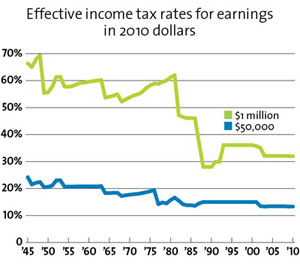
Will the Economy Notice?
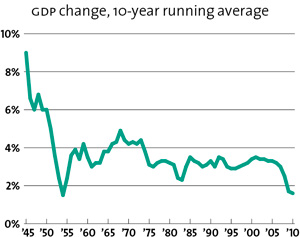
Myth #4: Regulatory uncertainty is clogging the economy.
Are American businesses paralyzed by fear of a tidal wave of new regulations? When McClatchy reporter Kevin Hall went out and asked small-business owners about this, he got a clear answer. “Absolutely, positively not,” said one. “Government regulations are not choking our business,” said another. In its most recent quarterly survey (PDF) of small-business trends, the National Federation of Independent Business reports that sales—i.e., lack of demand—is the No. 1 concern, beating out taxes, regulations, inflation, and everything else.
The Bottom Line Is the Bottom Line
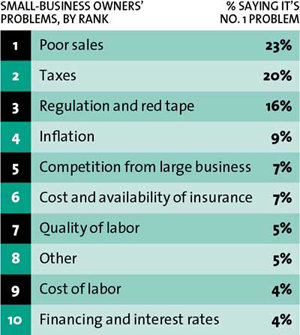
In any case, regardless of what the Wall Street Journal editorial page says, the Obama administration has hardly been a whirlwind of regulatory activity. Its health care reform will have very little effect on either small businesses (which are exempt) or large businesses (which mostly offer health plans already) and only a modest effect on medium-size businesses (PDF). Its financial reform bill affects only the financial sector. Its proposed new air-quality regulations will mostly affect old coal-fired electrical plants that would have shut down anyway (PDF).
Dumb and outdated regulations are no friends to the economy—and the Obama administration has undertaken a regulatory review that’s projected to save an estimated $10 billion during the next five years. But as welcome as that is, our economy’s biggest problem right now isn’t regulatory uncertainty. It’s economic uncertainty.
Myth #5: Obama is debasing the dollar.
In one of the most infamous moments of his young candidacy, Republican presidential hopeful Rick Perry decided to tee off on Federal Reserve Chairman Ben Bernanke last summer. “If this guy prints more money between now and the election,” he told an enthusiastic audience in Cedar Rapids, “I don’t know what y’all would do to him in Iowa, but we would treat him pretty ugly down in Texas.”
Bernanke’s sin? Pumping money into the banking system after the collapse of 2008. Although this is widely credited with helping prevent a second Great Depression, tea partiers and gold bugs are convinced that Bernanke’s actions have debased the dollar. There are two problems with that claim. First, it’s not true. Second, we’d be better off if it were.
First things first: Has the dollar lost value under Bernanke and Obama? No. The usual measure for the strength of the dollar is called “trade-weighted value.” In July 2008, just before the financial crisis erupted in earnest, the greenback’s value stood at 95.4. As I’m writing this in mid-September, it has gone up, then down, and is currently sitting at 96.1. Taking a longer view, the dollar lost value under Reagan and Bush I, gained value under Clinton, lost value under Bush II, and has mostly stayed steady under Obama. There’s just no basis to the claim that Obama and Bernanke have debased the currency.
And that’s unfortunate. As economist Dean Baker is fond of pointing out, if we want to get our national savings rate up and our long-term budget deficit down, there’s only one way to do it: by fixing our massive trade deficit. We have to import less and export more, and one way to make that happen is with a weaker dollar. A weaker dollar makes foreign goods more expensive, so we’ll buy less of them, and makes American goods cheaper, so others will buy more of them.
The truth is that we’d be better off if we ditched the loaded “strong/weak” terminology and just talked about an “export dollar” (weak) and an “import dollar” (strong). Sometimes one is good, and sometimes the other is. The Chinese, for example, have done well for decades with an export yuan. Likewise, an export dollar would be our friend right now.
Bad News for Tourists…
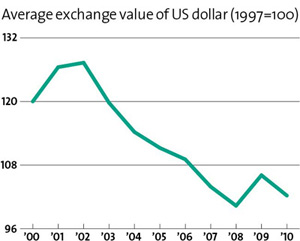
Is a Holiday for Manufacturers
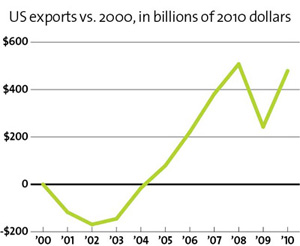
Myth #6: If you unshackle the rich, they’ll rev up the economy.
Think of this as the supermyth—the one underlying so many other fallacies. For decades, America’s economic policies have been based on the notion that catering to corporations and the wealthy is the way to stimulate the economy. Republicans routinely insist that we need to bail them out, lower their taxes, allow them to repatriate hundreds of billions in overseas profits, and free them from annoying government meddling. If we don’t, the “job creators” will stay in a funk, and the economy will stay in a rut.
But here’s a pesky fact neither corporate America nor the GOP establishment is trumpeting: After-tax corporate profits are currently at an all-time high. The problem businesses face isn’t lack of cash but rather a lack of confidence that consumer demand will pick up in the future. So they’re not expanding or hiring at the rate they should be.
Rich people don’t create jobs when we hand them big windfalls. They create jobs when the economy is growing and they have customers for their businesses. And the key to solving that problem, at least during a deep economic slump like the one we’re in now, is to focus like a laser on more stimulus, easier money, higher inflation, and a weaker currency. Unless we want to relive 1937 over and over and over again. As Bill Murray said, “Anything different is good.”
Wall Street’s Gain…
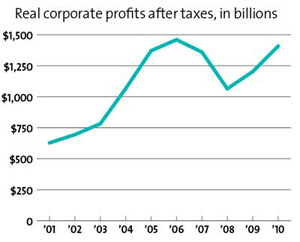
Main Street’s Pain
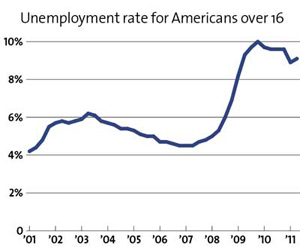
Click here for more information on the charts that appear in this story.

